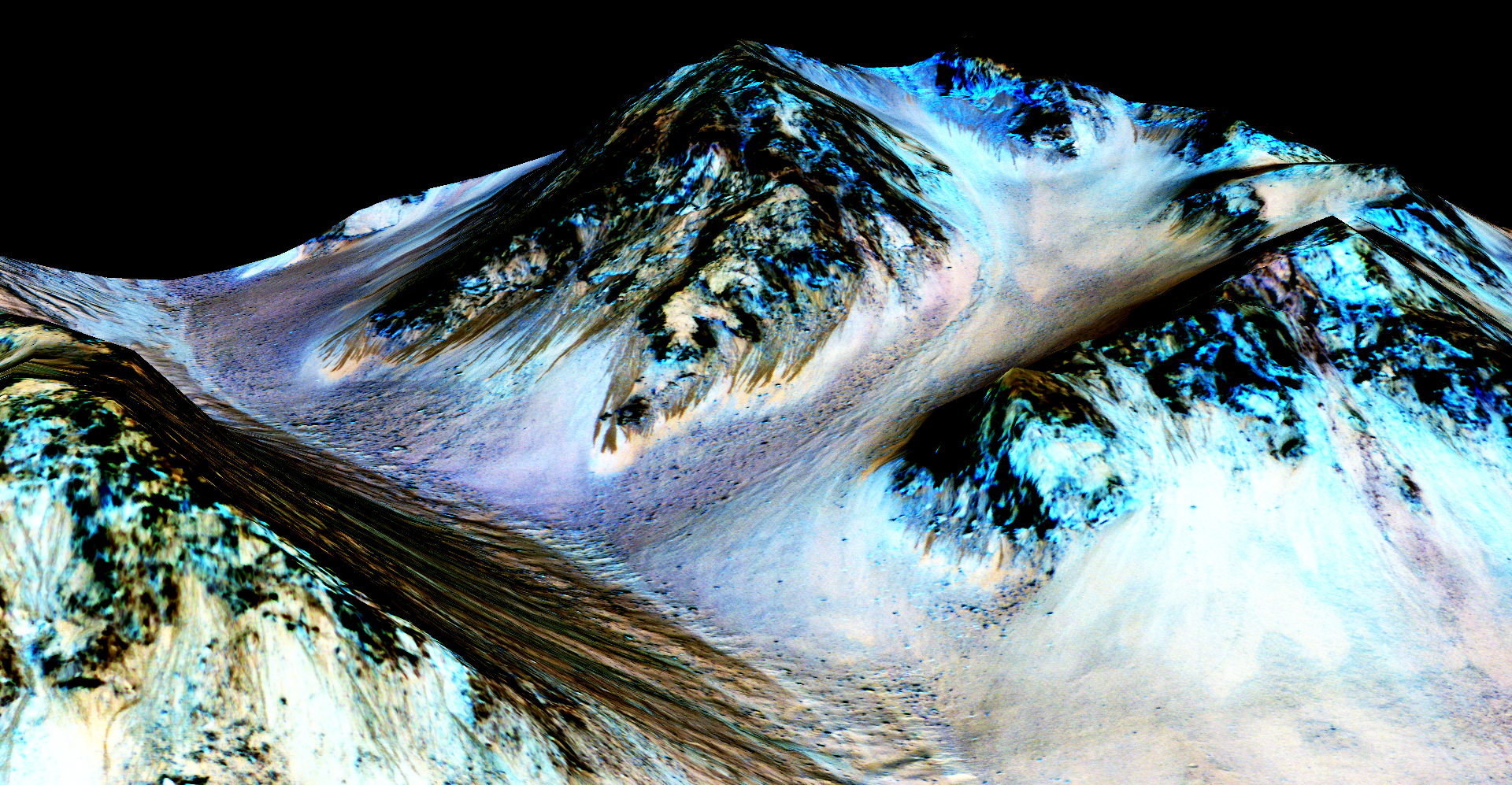Today, NASA made an exciting announcement about Mars. New information out of NASA’s Mars Reconnaissance Orbiter (MRO) confirms that sporadic salty water movement is taking place on the red planet.
It had been previously speculated that dark downhill flowing streaks (known as recurring slope lineae (RSL)), occurring seasonally on the slopes of Mars, were somehow related to water. During warm seasons, the streaks would darken and look like they were moving, then they would dissipate during colder seasons. Now, the detection of hydrated minerals on the slopes where the RSL happen, prove that water does exist on Mars.
John Grunsfeld, astronaut and associate administrator of NASA’s Science Mission Directorate in Washington, said, “Our quest on Mars has been to ‘follow the water,’ in our search for life in the universe, and now we have convincing science that validates what we’ve long suspected. This is a significant development, as it appears to confirm that water — albeit briny — is flowing today on the surface of Mars.”

An imaging spectrometer aboard NASA’s Mars Reconnaissance Orbiter (MRO) found the hydrated minerals in the same place as the dark streaks. The hydrated salts would be responsible for decreasing the freezing point for liquid brine, causing it to turn into liquid, salty, water – the same way it works when we throw salt down to melt ice quickly when it accumulates on our roads in the winter. The water moves as a shallow subsurface flow, with just enough liquid being drawn to the surface to cause the dark streaks.
Lujendra Ojha of the Georgia Institute of Technology (Georgia Tech) in Atlanta is the lead author of a report on the findings published on September 28 by Nature Geoscience. He stated, “We found the hydrated salts only when the seasonal features were widest, which suggests that either the dark streaks themselves or a process that forms them is the source of the hydration. In either case, the detection of hydrated salts on these slopes means that water plays a vital role in the formation of these streaks.”
As an undergraduate student at the University of Arizona in 2010, he discovered the bizarre features when studying images from MRO’s High Resolution Imaging Science Experiment (HiRISE). There have been several dozen sites on Mars documented now, thanks to observations made by HiRISE. HiRISE observations have been paired with mineral mapping completed by MRO’s Compact Reconnaissance Imaging Spectrometer for Mars (CRISM) for the new study.
Though the characteristics of hydrated salts were found in many locations where there were RSL, it only happened when the dark features were wide, comparatively. Researchers examined the same areas when the RSL were not as vast and found that no hydrated salt existed.

The hydrated minerals (called perchlorates) produced a spectral signature — the difference in the reflectance/emittance characteristics with respect to wavelengths — that Ojha and his co-authors explained. According to them, the hydrated salts most consistent with the chemical signatures are likely a mixture of magnesium perchlorate, magnesium chlorate, and sodium perchlorate. In temperatures as low as minus 94 degrees, there are some perchlorates that can keep liquids from freezing. There are even perchlorates on Earth, found in deserts, that are naturally produced and some varieties are even utilized as rocket propellant.
This is the first time perchlorates have been found from a spacecraft orbiting Mars. They were found prior to this by NASA’s Phoenix lander and its Curiosity rover in soil samples on the red planet, and it was thought by some scientists that signatures of the salts were even measured by the Viking missions in the 1970’s. However, the perchlorates that have been newly discovered are in hydrated form and in different locations than those previously found.
Since 2006, Mars has been under the watchful eye of MRO and its six science instruments. “It took multiple spacecraft over several years to solve this mystery, and now we know there is liquid water on the surface of this cold, desert planet,” said Michael Meyer, lead scientist for NASA’s Mars Exploration Program at the agency’s headquarters in Washington. “It seems that the more we study Mars, the more we learn how life could be supported and where there are resources to support life in the future.”
The new information learned is just further confirmation that five years ago, when Ojha glanced upon darkening Martian slopes for the very first time, he was seeing water movement. “When most people talk about water on Mars, they’re usually talking about ancient water or frozen water. Now we know there’s more to the story. This is the first spectral detection that unambiguously supports our liquid water-formation hypotheses for RSL.” Ojha said.




